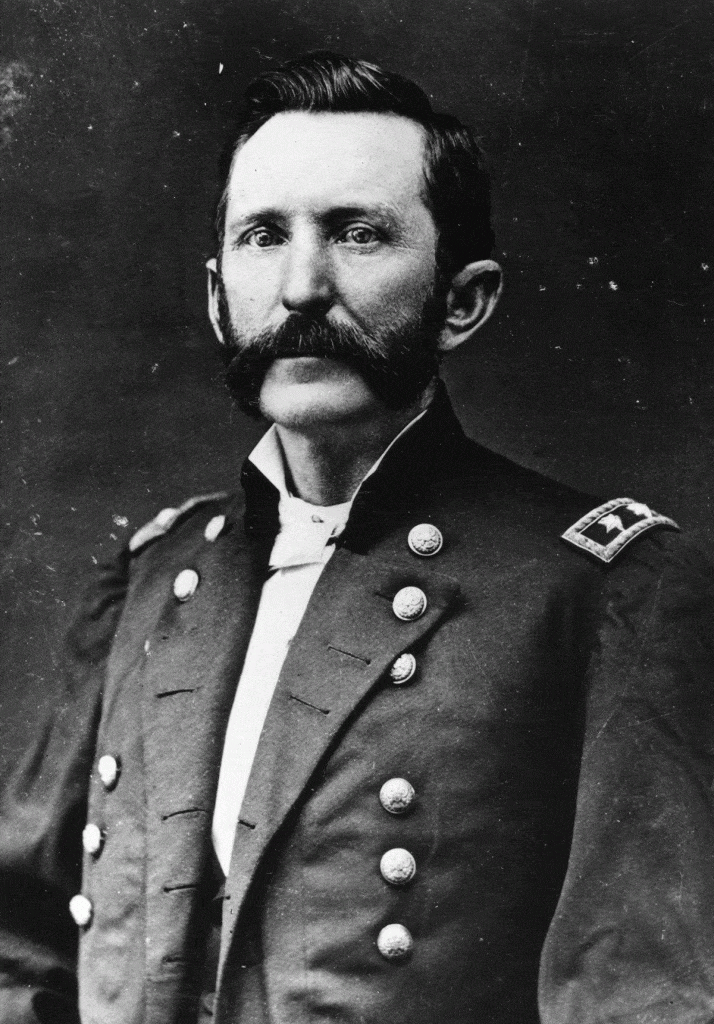Welcome back to our second article discussing the impact of the first Transcontinental Railroad on the development of Park City.
At the onset of the Civil War, Patrick E. Connor volunteered for a third tour of duty in the U.S. Army. He was then living in California. Assigned the rank of Colonel, Connor assumed command of the 3rd California Volunteer Infantry numbering 2,500 troops. Their orders: establish a post in the Salt Lake Valley to protect the overland mail route and telegraph lines, and ensure that Brigham Young remained faithful to the Union.

Credit: Park City Historical Society & Museum, Himes-Buck Digital Collection
Neither Connor nor his troops relished their deployment to Salt Lake. They were a world away from the real fighting, their post was remote, and they were outnumbered by the Mormon militia four to one.
Their first order of business – establish a command post. For this Connor selected a plateau three miles east of Salt Lake City. Thus Camp Douglas was established in October 1862, renamed Fort Douglas in 1878. Their second and much greater challenge: dilute the Mormon monopoly and do it peacefully.
The impact of the California Gold Rush (1848-1855) on that territory cannot be overstated. As one example, in 1846 the population of San Francisco was 200 – by 1852 it was 36K. The combined population and economic growth resulted in California becoming a state with the Compromise of 1850. Connor and some of his men were veterans of the California Gold Rush. Connor himself had realized $85K in profits (a value of approximately $2.7M in 2020). The Colonel dreamed of a Utah Gold Rush – but how?
Connor’s local foil, Brigham Young, had professed neutrality to the Southern cause. He and his followers allowed slavery in the Utah Territory until June 1862 when it was outlawed by Federal decree. One activity Young aggressively opposed, however, was prospecting. He considered it a “lustful pursuit”.
He knew well the consequences of the California Gold Rush. In 1862 approximately 50K people lived in the Utah Territory, most of them Mormon. Connor’s “dream” was a nightmare for Young. Fortunately, the remoteness of the Utah Territory ensured that transportation costs were prohibitive to creating a viable mining industry. This would soon change.
The Pacific Railroad Act of 1862 ensured that rails would bind the Utah Territory to the Union. “When” was a different story. No matter to Connor and his men – they weren’t building the railroad. However, they could “set the stage” for a Utah Gold Rush.
In November 1863 Connor helped organize the Wasatch Mountain Mining District. In the spring of 1864 the mountains were systematically explored using techniques perfected in California. Commensurate with their prospecting, Connor utilized the telegraph to communicate sensationalized accounts regarding gold and silver possibilities in the Wasatch Mountains. Published in northern newspapers, these stories attracted the attention of speculators and miners as the boulevard of iron expanded westward.
In May 1869 the Pacific Railroad passed through Echo, Utah, coming within twenty-seven miles of Parley’s Park (as the area was referred to before the establishment of Park City). Consider that before 1869 crossing the continent either by land or sea took five to six months by wagon or ship. Under the best of circumstances it was an arduous, expensive and life-threatening journey.
By June 1869 that same journey took four days! The railroad established cost-effective, reliable transportation which was absolutely necessary to create a “Utah Gold Rush.” Prospectors, speculators, miners and financiers came pouring in.
Park City was incorporated in 1884. Rails reached the town directly by 1890. And by 1898 7,500 people lived in Park City working directly or indirectly for the burgeoning mining industry. Connor’s California Dreamin’ had become a reality.
Be sure to check out A World Transformed: The Transcontinental Railroad and Utah at the Park City Museum. The exhibit will be up until March 15.